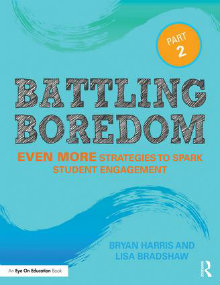Battle Boredom with Student Engagement
Battling Boredom: Even More Strategies to Spark Student Engagement, Part 2
By Bryan Harris and Lisa Bradshaw
(Routledge, 2018 – Learn more)

Teachers, we have to admit it. Sometimes our students are bored. That’s a problem. A big problem. Why? Because even if we keep teaching our hearts out, students who are bored with what we are saying will not learn. We’ve got to fight classroom boredom to reach and teach our students.

Boredom busters to use right away
After a very short introduction that outlines the dangers of a boring classroom, the book is all practical strategies. There are seven categories of boredom busters.
- Academic Talk: Strategies to deepen engagement, thinking, and understanding of content through meaningful talk.
- Energizers: Ideas for getting students’ blood pumping to their brains with quick physical activity.
- Feedback: Advice for giving students meaningful feedback and teaching them to offer feedback to others (including you!).
- Questioning: Tips, hints, and ideas for making the most out of the questions you ask to engage students.
- Technology: Strategies for harnessing the power of technology to hook students into learning.
- Vocabulary: Engaging, interactive ideas for making vocabulary learning fun and impactful.
- Writing: A set of ideas aimed to help you use writing for learning (in contrast to helping students learn to write).
Each chapter offers several practical ideas, all of which include an overview of the strategy, step-by-step instructions for using it, and tips and variations that you can try.
Outdated practices that bring on the snores
The final chapter offers a list of commonly used strategies that the authors claim do not work in the war against boredom. They include the following:
Academic Decathlons: These and other activities that eliminate students “tournament style” allow some students to disengage.
Copying: This strategy may keep students quiet so it looks like they are engaged, but the authors are adamant that copying leads to compliance, not engagement.
Extended Lecture: We have been warned about the low-effect strength of the lecture method for years. The authors remind us that, given students’ actual attention spans, extended lectures are little more than a waste of everyone’s time.
Allowing for Optional Participation: All students can and should be required to participate. In this same vein, the authors caution against asking questions where you call a student’s name first. For example, instead of saying, “John, can you tell how to determine theme?” you should say, “Class, can you tell me how to determine the theme?” You can still call on John, but this way the entire class is more likely to think about the answer.
Shifting to a collaborative classroom

Rita Platt (@ritaplatt) is a National Board Certified Teacher with master’s degrees in reading, library, and leadership. Her experience includes teaching learners in remote Alaskan villages, inner cities, and rural communities. She currently is a teacher-librarian, teaches graduate courses for the Professional Development Institute and writes for We Teach We Learn. She recently launched Heart of the School, a MiddleWeb blog.

































